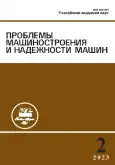Finite Element Simulation of Hybrid Additive Technology Using Laser Shock Processing
- 作者: Sakhvadze G.Z.1
-
隶属关系:
- Mechanical Engineering Research Institute of the Russian Academy of Sciences, 101900, Moscow, Russia
- 期: 编号 2 (2023)
- 页面: 94-102
- 栏目: НОВЫЕ ТЕХНОЛОГИИ В МАШИНОСТРОЕНИИ
- URL: https://journals.rcsi.science/0235-7119/article/view/137579
- DOI: https://doi.org/10.31857/S0235711923020074
- EDN: https://elibrary.ru/CPDMRD
- ID: 137579
如何引用文章
全文:
详细
Metal products manufactured by means of additive technologies are usually characterized by unfavorable mechanical properties. Laser shock processing is mechanical processing of surfaces at a high strain rate, which hardens the near-surface layer and creates favorable mechanical properties. This work discusses the development of hybrid additive technology in combination with laser shock processing with additive technologies, and the role of laser shock processing in hybrid additive technology is analyzed using the finite element method. The results obtained demonstrate that the frequency of the hardened layer is a critical technological parameter influencing the redistribution of residual stresses, which strongly depends on the amount of heat released during 3D printing. Due to the results obtained, the hybrid additive technology developed occupies a position in various additive technologies and is promising for practical implementation as a new method for manufacturing high-quality metal products.
作者简介
G. Sakhvadze
Mechanical Engineering Research Institute of the Russian Academy of Sciences, 101900, Moscow, Russia
编辑信件的主要联系方式.
Email: sakhvadze@mail.ru
Россия, Москва
参考
- Huang Y., Leu M.C., Mazumder J. et al. Additive manufacturing: current state, future potential, gaps and needs, and recommendations // J. Manuf. Sci. Eng. 2015. V. 137. P. 1.
- Sealy M.P., Madireddy G., Willims R. et al. Hybrid processes in additive manufacturing // J. Manuf. Sci. Eng. 2018. V. 140. P. 1.
- Manvatkar V.D., Gokhale A.A., Jagan R. et al. Estimation of melt pool dimensions, thermal cycle, and hardness distribution in the laser-engineered net shaping process of austenitic stainless steel // Metall. Mater. Trans. 2011. V. 42. P. 1.
- Heigel J.C., Michaleris P., Reutzel E.W. Thermo-mechanical model development and validation of directed energy deposition additive manufacturing of Ti-6A1-4V // Addit. Manuf. 2015. V. 5. P. 9.
- Wang L., Felicelli S.D., Pratt P. Residual stresses in LENS-deposited AISI410 stainless steel plates // Mater. Sci. Eng. A. 2008. V. 496. P. 234.
- Chiumenti M., Lin X., Cervera M. et al. Numerical simulation and experimental calibration of additive manufacturing by blown powder technology. Part I: thermal analysis // Rapid Prototyp. J. 2017. V. 23. P. 448.
- Anca A., Fachinotti V.D., Escobar-Palafox G. et al. Computational modelling of shaped metal deposition // Int. J. Numer. Methods Eng. 2011. V. 85. P. 84.
- Chiumenti M., Cervera M., Salmi A. et al. Finite element modeling of multi-pass welding and shaped metal deposition processes // Comput. Methods Appl. Mech. Eng. 2010. V. 199. P. 2343.
- Peyre P., Aubry P., Fabbro R. et al. Analytical and numerical modeling of direct metal deposition laser process // J. Phys. Appl. 2008. V. 41. P. 1.
- Denlinger E.R., Heigel J.C., Michaleris P. Residual stress and distortion modeling of electron beam direct manufacturing Ti-6AI-4V // Proceedings of the IMechE. 2015. V. 229. P. 1803.
- Marimuthu S., Clark D., Allen J. et al. Finite element modelling of substrate thermal distortion in direct laser additive manufacture of an aero-engine component // Proc. IMechE. 2013. V. 227. P. 1987.
- Voothaluru R., Richard L.C., Cheng G.J. Finite element analysis of the variation in residual stress distribution in laser shock peening of steels // J. Manuf. Sci. Eng. 2012. V. 134. P. 061010.
- Sealy M.P., Madireddy G., Li C. et al. Finite element modeling of hybrid additive manufacturing by laser shock peening // Proc. Annual Int. Solid Freeform Fabrication Symposium. 2016. P. 306.
- Anurag S., Guo Y.B., Horstemeyer M.F. The effect of materials testing modes on finite element simulation of hard machining via the use of internal state variable plasticity model coupled with experimental study // Comput. Struct. 2009. V. 87. P. 303.
- Shah S.M., Nelias D., Zain-ul-abdein M. et al. Numerical simulation of grinding induced phase transformation and residual stresses in AISI-52100 steel // Finite Elem. Anal. Des. 2012. V. 61. P. 1.
- Sakhvadze G.Zh., Sakhvadze G.G., Kavtaradze R.Z. Increasing the Crack Resistance of Materials by Means of Laser Shock Processing // Russian Engineering Research. 2021. V. 41. № 1. P. 27.
- Sakhvadze G.Zh. Simulation of the Technology of Laser-Shock-Wave Processing of Titanium Alloys with Shape Memory Using Dimensional Analysis // J. of Machinery Manufacture and Reliability. 2021. V. 50. № 4. P. 332.
- Adu-Gyamfi S., Ren X.D., Larson E.A. et al. The effects of laser shock peening scanning patterns on residual stress distribution and fatigue life of AA2024 aluminium alloy // Opt. Laser Technol. 2018. V. 108. P. 177.
- Huang S., Sheng J., Wang Z. et al. Finite element and experimental analysis of elevated-temperature fatigue behavior of IN718 alloy subjected to laser peening // Int. J. Fatigue. 2020. V. 131. P. 105337.
- Xu S., Huang S., Meng X. et al. Thermal evolution of residual stress in IN718 alloy subjected to laser peening // Opt. Lasers Eng. 2017. V. 94. P. 70.
补充文件














